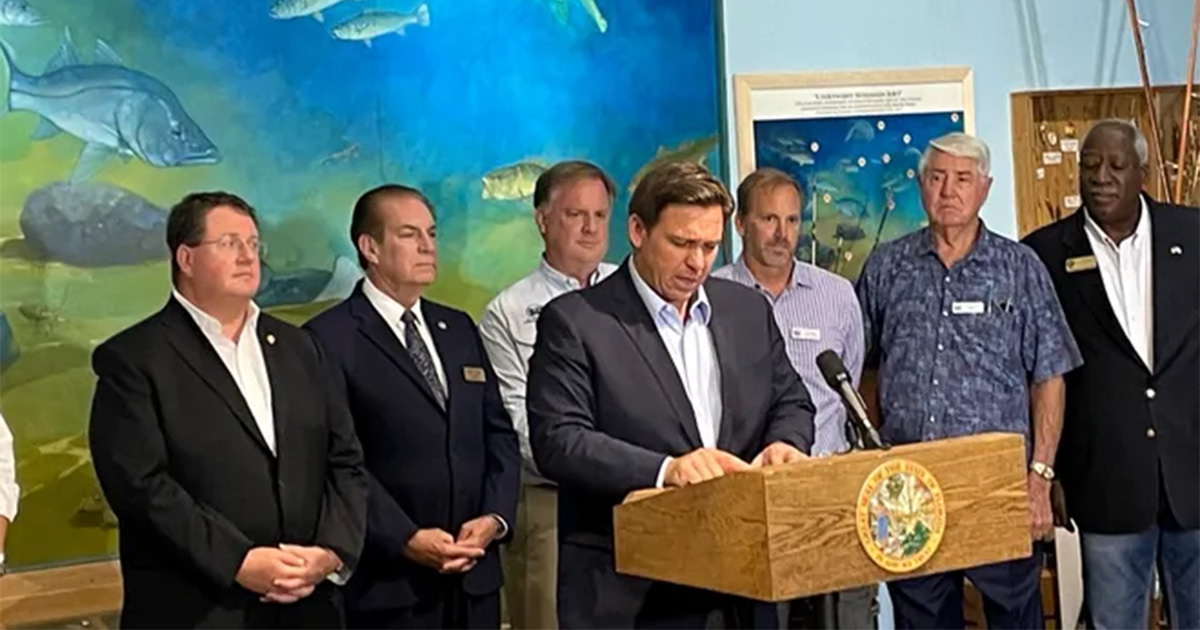Governor Ron DeSantis signed Executive Order 23-06 (Achieving Even More Now for Florida’s Environment), to further advance the protection of Florida’s environment and water quality.
The Executive Order directs strategic action with a focus on accountability, sound science, progress, and collaboration and includes a proposed $3.5 billion investment over four years for Everglades restoration and protection of our water resources, surpassing the historic investments of the past four years and making it the highest level of funding in Florida’s history. More information on Executive Order 23-06 can be found here.
“Four years ago, I promised to pursue a bold agenda and to commit to lead Florida into a new era of stewardship for Florida’s natural resources, and we delivered,” said Governor Ron DeSantis. “Today, I am proud to announce the next step in this administration’s continued dedication to Florida’s treasured environment. This order directs funding and strategic action that will continue our momentum and enhance our ongoing efforts to expedite critical Everglades restoration projects, employ sound science to protect and restore our waterways, and fund infrastructure projects to improve water quality and safeguard Florida’s water supply.”
“Under Governor DeSantis’ leadership and with the support of the Florida Legislature, the state has taken unprecedented steps to effectively address our most pressing environmental issues,” said Department of Environmental Protection Secretary Shawn Hamilton. “With this renewed support and direction, Florida’s environment will remain a priority and we will continue to have the resources to bolster our long-term environmental programs and meet the needs of our diverse state.”
“Governor Ron DeSantis’ Executive Order 23-06 ramps up our efforts to accomplish even more to protect and restore Florida’s environment,” said South Florida Water Management District Governing Board Chairman Chauncey Goss. “In Governor DeSantis’ first term, we broke ground on, hit a major milestone, and completed more than 50 Everglades restoration projects. Because of his unwavering commitment to our natural resources, the South Florida Water Management District will be able to do more to move water south, reduce harmful discharges, and improve water quality. I cannot think of a better way to recognize the anniversary of Executive Order 19-12 than to set out Florida’s boldest environmental agenda yet with the signing of Executive Order 23-06.”
“Governor Ron DeSantis has long demonstrated his continued commitment to protecting Florida’s waterways and critical natural resources,” said Chief Science Officer Dr. Mark Rains. “Thanks to his leadership and the historic amounts of funding his administration has secured during his first term; the state is now in a position where we can build on previous environmental successes and take continued strategic action to improve water quality. I look forward to working with the Blue-Green Algae Task Force and other stakeholders to continue accelerating achievements for Florida’s environment.”
“When it comes to protecting Florida’s environment and enhancing the resilience of our communities, Governor DeSantis has already amassed one of the most consequential tenures in the state’s history,” said Chief Resilience Officer Dr. Wes Brooks. “Today, our Governor set an even more ambitious floor for what Floridians can expect from state government over the next four years. From ensuring that all local flood risk planning and adaptation efforts are informed by comprehensive vulnerability assessments to launching a cutting-edge restoration and recovery initiative for Florida’s Coral Reef, I’m excited to get to work delivering on the Governor’s bold commitments and inspiring vision for Florida’s future.”
Key provisions of Executive Order 23-06 include directing the Department of Environmental Protection (DEP) to:
- Secure an historic $3.5 billion over the next four years for Everglades restoration and protection of our water resources, including water quality and water supply.
- Prioritize the protection of the Indian River Lagoon (IRL) and secure at least $100 million annually for priority projects to improve water quality in the IRL.
- Expand the existing Wastewater Grant Program by broadening project eligibility to address impacts to water quality from nonpoint sources such as stormwater and agricultural runoff.
- Ensure that all wastewater facilities discharging to waterbodies within a basin management action plan (BMAP) area or waterbody not attaining water quality standards upgrade to advanced wastewater treatment by 2033.
- Coordinate with the Department of Economic Opportunity to improve local government long-term comprehensive planning to encourage successful and sustainable growth while protecting natural resources.
- Strengthen BMAPs, which provide a roadmap to restoring water quality and reducing pollutants, to include the specific projects necessary to meet the requisite water quality standards to achieve restoration goals.
- Ensure continued funding for statewide resilience projects through the Resilient Florida Program.
- Take all necessary steps to expedite the state’s land conservation efforts, including a strategic focus on acquisitions within the Wildlife Corridor.
The order also directs the South Florida Water Management District (SFWMD) to:
- Continue to expedite Comprehensive Everglades Restoration Program (CERP) projects.
- Make every effort to ensure meaningful progress on Everglades restoration projects undertaken by the U.S. Army Corps of Engineers (Corps), including the Everglades Agricultural Area (EAA) Reservoir Project.
- Work with the Corps to ensure the Lake Okeechobee System Operating Manual (LOSOM) is implemented in a manner that reduces discharges to the St. Lucie and Caloosahatchee estuaries and sends more water south to benefit the environment and meet the needs of our communities.
Other key provisions include:
- Continuation of efforts by the Blue-Green Algae Task and Harmful Algal Bloom Task Forces.
- Continuation of the red tide emergency grant program and creation of a similar blue-green algae grant program to support state and local government response efforts.





